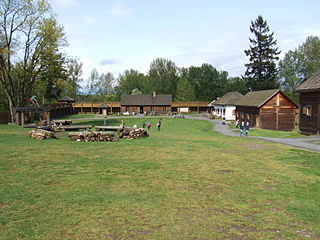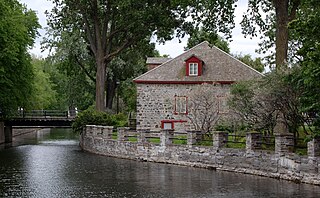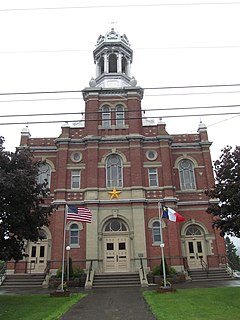
Bellows Falls is an incorporated village located in the town of Rockingham in Windham County, Vermont, United States. The population was 3,148 at the 2010 census. Bellows Falls is home to the Green Mountain Railroad, a heritage railroad; the annual Roots on the River Festival; and the No Film Film Festival.

Fort Langley National Historic Site, commonly shortened to Fort Langley, is a former fur trading post of the Hudson's Bay Company in the community of Fort Langley of Langley, British Columbia, Canada. The national historic site sits above the banks of the Bedford Channel across McMillan Island. The national historic site contains a visitor centre and a largely reconstructed trading post that contains ten structures surrounded by wooden palisades.

The Fur Trade at Lachine National Historic Site is a historic building located in the borough of Lachine in Montreal, Quebec, Canada, at the western end of the Lachine Canal. It is a National Historic Site of Canada.

The Astor Fur Warehouse is a historic fur warehouse located at Bolvin and Water Streets on St. Feriole Island in Prairie du Chien, Wisconsin. Jean Joseph Rolette, an agent of the American Fur Company, built the warehouse in 1828. The warehouse was used until the mid-19th century; it has since been incorporated into the Villa Louis museum. The building, now a National Historic Landmark, is the only known surviving fur trade warehouse in the upper Mississippi valley.

Rail and Titsworth Canal Warehouse, also known as DeCilio's, is a historic canal warehouse building located at Belfast in Allegany County, New York. It is the oldest surviving warehouse from along the route of the Genesee Valley Canal, later Genesee Valley Canal Railroad. It was built about 1853 in the Greek Revival style. Built originally as a warehouse, over the years the structure has been used as a hotel, brothel, barn, and storehouse.

St. David Catholic Church is a historic church at 774 Main Street in Madawaska, Maine. Built in 1911, it is an architecturally distinctive blend of Baroque and Italian Renaissance architecture. The congregation was the first separate Roman Catholic congregation established in Madawaska, the result of many years' struggle, after the international border divided the French Catholic community here in 1842. The building was listed on the National Register of Historic Places in 1973.

Montgomery Park is an office building and former Montgomery Ward mail-order catalog warehouse and department store located in Portland, Oregon, United States, built in 1920. It is listed on the National Register of Historic Places under its historic name Montgomery Ward & Company Building. The building is located on property once used for the Lewis and Clark Centennial Exposition, of 1905. It was occupied by Montgomery Ward from 1920 until 1985, although the majority of the company's operations at this location ended in 1982. The building is the second-largest office building in Portland with 577,339 square feet (53,636.5 m2).

The William O. Munsell House in southeast Portland in the U.S. state of Oregon is a 1.5-story single dwelling listed on the National Register of Historic Places. Built in an eclectic mixture of Bungalow, American Craftsman, and Colonial Revival styles in 1902, it was added to the register in 1989.

The Meier & Frank Delivery Depot, located in northwest Portland, Oregon, is listed on the National Register of Historic Places. Built for Portland retailing company Meier & Frank, the building was designed by Sutton & Whitney and constructed in 1927. From 1986 to 2001, the building was owned by the Oregon Historical Society, for processing of items and storage of its collections.

The Meier & Frank Warehouse, located in northwest Portland, Oregon, is listed on the National Register of Historic Places. Built in 1923 for longtime Portland-based retail company Meier & Frank, it was added to the National Register in 2000.

The Blake McFall Company Building, also known as the Emmett Building, in southeast Portland in the U.S. state of Oregon, is a five-story commercial warehouse listed on the National Register of Historic Places. Designed by McNaughton & Raymond of Portland and built in 1915, it was added to the register in 1990. The 100-by-200-foot structure is representative of a group of timber-framed loft warehouses built in the early 20th century on the east side of the Willamette River.

Sutton & Whitney was an architecture firm based in Portland, Oregon, United States, operating from 1912 to 1950. Its principal partners were Albert Sutton (1866–1923) and Harrison A. Whitney (1877–1962). In 1934, it became Sutton, Whitney & Aandahl, after full membership was granted to Frederick Aandahl (1887–1950), who had already been working for the firm as chief draftsman since 1919 and as an associate since 1923.

The Nashua Manufacturing Company Historic District in Nashua, New Hampshire, is a historic district that was listed on the National Register of Historic Places (NRHP) in 1987. It encompasses an area just west of downtown Nashua, roughly located along the southern bank of the Nashua River, bordered on the west side by Mine Falls Park, on the south side by the Nashua River canal, up to Ledge Street, and from the east side by Factory, Pine and Water streets, up to the Main Street bridge.

The North Troy–Highwater Border Crossing connects the town of Highwater, Quebec with North Troy, Vermont on the Canada–US border. It is located at the meeting point of Vermont Route 243 and Quebec Route 243. Both stations are open 24 hours per day for non-commercial traffic; the Canadian station is open to commercial traffic on weekdays during business hours. The former US station facilities, dating to the 1930s, are listed on the National Register of Historic Places.

Storehouse No. 4, also known as the Eagle Point Storehouse, is an historic storehouse located on International Street in Hyder, Alaska. It was built in 1896 under supervision of engineer David du Bose Gaillard. It was listed on the National Register of Historic Places in 1976.

The Howard Hardware Storehouse is a historic storage building off Bridge Street in Bellows Falls, Vermont. Built about 1895, it is a surviving reminder of the city's railroad-related economic past, built in a distinctive tetrahedral shape to accommodate nearby railroad lines. It was listed on the National Register of Historic Places in 1990.

The Old Wadena Historic District is a concentration of historical archaeology sites now largely contained within Old Wadena County Park in Thomastown Township, Minnesota, United States. Features include the sites of four successive trading posts established in 1782, 1792, 1825, and 1856; the original townsite of Wadena on the Red River Trails; and the county's first farm. The town was later moved 3.5 miles (5.6 km) south to its present location. The historic district was listed on the National Register of Historic Places in 1973 for having state-level significance in the themes of agriculture, non-aboriginal archaeology, and transportation. It was nominated for its archaeological potential at the seminal site of Euro-American activity in Wadena County, Minnesota.

The Jefferson Grain Warehouse is a historic warehouse in Jefferson Township, Minnesota, United States, built in 1868 on the bank of the Mississippi River. The warehouse was listed on the National Register of Historic Places in 1994 for having local significance in the themes of commerce and transportation. It was nominated for being a rare surviving reminder of a brief period when wheat was becoming the most important agricultural crop of the Upper Midwest yet steamboats were still the leading form of transportation.

Hurstville Historic District is a nationally recognized historic district located north of Maquoketa, Iowa, United States. It was listed on the National Register of Historic Places in 1979. At the time of its nomination it included three areas: the former lime manufacturing works, a farmstead, and the townsite. All that remains are the four kilns, and an old warehouse. Both the townsite, which was across the road and to the southwest, and the farmstead, which was behind the kilns to the south, are gone. Also gone are the remaining company buildings, with the exception of the old warehouse, which were across the road to the west. The houses in the townsite were side-gable cottages. Many lacked indoor plumbing into the 1970s and were vacant. The farmstead included 20 structures devoted to domestic or agricultural use. Two large barns were the most notable structures. The farm served the needs of the town. The most significant structures in the district were the lime kilns.






















